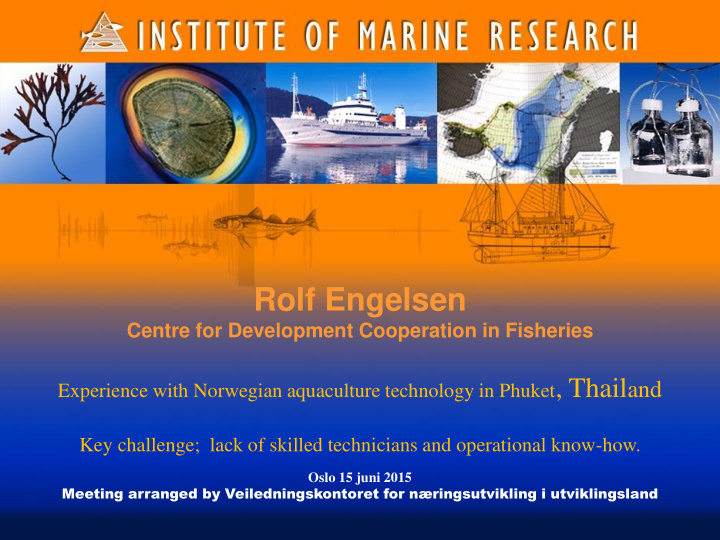



Rolf Engelsen Centre for Development Cooperation in Fisheries Experience with Norwegian aquaculture technology in Phuket , Thail and Key challenge; lack of skilled technicians and operational know-how. Oslo 15 juni 2015 Meeting arranged by Veiledningskontoret for næringsutvikling i utviklingsland 1
Thailand Project objectives • Mastering of operation of modern marine farms; big cages and intensive marine hatcheries • Improved innovation in marine aquaculture and spread of new (modern) technologies • Elaboration of general regulations incl. fish health and environmental areas • Strengthening of Government competence and governance, improved public governance regarding auquaculture development 2
Transfer of know-how from Norway Marine Finfish Hatchery • Knowledge of bio security, use of quarantine, fish health monitoring program • Biological knowledge about nutrition demands to secure fish egg quality • Knowledge how to manipulate for a year round production. • Knowledge and protocols for a predictable mass live feed production • Knowledge and protocols to secure high quality live feed incl. bacterial control and enrichment • Technical know how regarding water quality / water treatment • Operational know how on all farming stages 3
Transfer of know-how from Norway cage farming • site selection • dead fish removal • species selection • feed and feeding • cage assemply • predator handling • cage installation • parasite treatment • net change • disease handling & • net cleaning prevention • stocking with fingerlings • crowding • data registration and • grading regular farm reports • harvesting ( growth, morts, temp., oxygen, predators etc. ) • slaughtering • processing 4 • (sales and export)
Use of ball line crowding fish
Production of rotifers
Larval production
Nursery section
Cobia on ice slaughtered for testing
Cobia Processing
Fillets of cobia
Portion cut of cobia
Sushi of Cobia from Pilot Farm
16
Tunas; Albacore, Atlantic Bluefin, Skipjack, Yellowfin and Bigeye 17
Results • Thai management capable of operating both the pilot cage farm and the demo hatchery • The new technology introduced is functioning • High quality fish is produced in the cages (cobia and now Asian Sea Bass) • High quality fingerlings is produced in the hatchery • Regulations are revised • The level of understanding modern aquaculture is dramatically improved 18
Review by Norad 27/8 2009 • Furthermore, because of the success of this Project and the activities at the Phuket Center, one should consider the possibility of establishing regional cooperation in training and innovation, i.e. use the Phuket Center as a regional training and development center. • 19
CDCF advice and proposal: Phuket Competence & Training Center for Southeast Asia/Asean • Practical training in modern marine fish farms (Norwegian style) • Goal; Technical certificates? • Research and development work regarding key species • Exchange of researchers Norway – Thailand/Southeast Asia • Post Doc/Phd grants? 20
Skilled technicians (røktere) - the backbone of the Norwegian fish farming industry The skilled workers have fagbrev (technical certificate) I. Passing an exam (theoretical and practical issues) after 5 years of experience as a farm technician or II. 2 years in High School (VG1 + VG2 (aquaculture) and then 2 years apprenticship in a fish farming company (VG3) The industry is run on the farm level by practical people – The technology is ” no good ” if you don,t have the operational skills
FAO: Training and extension in aquaculture • Aquaculture is a practical science and hands- on training through demonstrations, pilot projects and training courses with a strong applied component are likely to be the most successful way of effecting this transfer. • Traditional teaching methods, with one expert lecturing to an assembly of farmers in a classroom, have their role to play, but this component of a training programme should be limited. 22
The Thailand CDCF Model • Emphazising a practical starting base • Demonstrating high quality cage and hatchery practical operations in the real local environment • Relevance and potential can be discussed based upon this base • Biosecurity and fish health management is elaborated on the same basis • Training can be based upon real functioning farms 23
Thank you 24
Recommend
More recommend